AZ-104 PDF Download - Microsoft Azure Administrator 2023 Updated: 2024

 |
 |
 |
 |
 |
 |
 |
 |
AZ-104 Microsoft Azure Administrator 2023
EXAM NUMBER : AZ-104
EXAM NAME : Microsoft Azure Administrator 2021
Candidates for this exam should have subject matter expertise implementing, managing, and
monitoring an organization’s Microsoft Azure environment.
Responsibilities for this role include implementing, managing, and monitoring identity,
governance, storage, compute, and virtual networks in a cloud environment, plus provision, size,
monitor, and adjust resources, when needed.
An Azure administrator often serves as part of a larger team dedicated to implementing an
organization's cloud infrastructure.
A candidate for this exam should have at least six months of hands-on experience administering
Azure, along with a strong understanding of core Azure services, Azure workloads, security, and
governance. In addition, this role should have experience using PowerShell, Azure CLI, Azure
portal, and Azure Resource Manager templates.
Skills:
- Manage Azure identities and governance (15-20%)
- Implement and manage storage (15-20%)
- Deploy and manage Azure compute resources (20-25%)
- Configure and manage virtual networking (25-30%)
- Monitor and back up Azure resources (10-15%)
Manage Azure identities and governance (15–20%)
Manage Azure Active Directory (Azure AD) objects
create users and groups
manage user and group properties
manage device settings
perform bulk user updates
manage guest accounts
configure Azure AD join
configure self-service password reset
Manage role-based access control (RBAC)
create a custom role
provide access to Azure resources by assigning roles at different scopes
interpret access assignments
Manage subscriptions and governance
configure Azure policies
configure resource locks
apply and manage tags on resources
manage resource groups
manage subscriptions
manage costs
configure management groups
Implement and manage storage (15–20%)
Secure storage
configure network access to storage accounts
create and configure storage accounts
generate shared access signature (SAS) tokens
manage access keys
configure Azure AD authentication for a storage account
configure access to Azure Files
Manage storage
export from Azure job
import into Azure job
install and use Azure Storage Explorer
copy data by using AZCopy
implement Azure Storage replication
configure blob object replication
Configure Azure files and Azure Blob Storage
create an Azure file share
create and configure Azure File Sync service
configure Azure Blob Storage
configure storage tiers for Azure Blob Storage
configure blob lifecycle management
Deploy and manage Azure compute resources (20–25%)
Automate deployment of virtual machines (VMs) by using Azure Resource Manager
templates
modify an Azure Resource Manager template
configure a virtual hard disk (VHD) template
deploy from a template
save a deployment as an Azure Resource Manager template
deploy virtual machine extensions
Configure VMs
configure Azure Disk Encryption
move VMs from one resource group to another
manage VM sizes
add data disks
configure networking
redeploy VMs
configure high availability
deploy and configure scale sets
Create and configure containers
configure sizing and scaling for Azure Container Instances
configure container groups for Azure Container Instances
configure storage for Azure Kubernetes Service (AKS)
configure scaling for AKS
configure network connections for AKS
upgrade an AKS cluster
Create and configure Azure App Service
create an App Service plan
configure scaling settings in an App Service plan
create an App Service
secure an App Service
configure custom domain names
configure backup for an App Service
configure networking settings
configure deployment settings
Configure and manage virtual networking (25–30%)
Implement and manage virtual networking
create and configure virtual networks, including peering
configure private and public IP addresses
configure user-defined network routes
implement subnets
configure endpoints on subnets
configure private endpoints
configure Azure DNS, including custom DNS settings and private or public DNS zones
Secure access to virtual networks
create security rules
associate a network security group (NSG) to a subnet or network interface
evaluate effective security rules
implement Azure Firewall
implement Azure Bastion
Configure load balancing
configure Azure Application Gateway
configure an internal or public load balancer
troubleshoot load balancing
Monitor and troubleshoot virtual networking
monitor on-premises connectivity
configure and use Network Performance Monitor
use Azure Network Watcher
troubleshoot external networking
troubleshoot virtual network connectivity
Integrate an on-premises network with an Azure virtual network
create and configure Azure VPN Gateway
create and configure Azure ExpressRoute
configure Azure Virtual WAN
Monitor and back up Azure resources (10–15%)
Monitor resources by using Azure Monitor
configure and interpret metrics
configure Azure Monitor logs
query and analyze logs
set up alerts and actions
configure Application Insights
Implement backup and recovery
create a Recovery Services vault
create and configure backup policy
perform backup and restore operations by using Azure Backup
perform site-to-site recovery by using Azure Site Recovery
configure and review backup reports
Microsoft Administrator PDF Download
Other Microsoft exams
MOFF-EN Microsoft Operations Framework Foundation62-193 Technology Literacy for Educators
AZ-400 Microsoft Azure DevOps Solutions
DP-100 Designing and Implementing a Data Science Solution on Azure
MD-100 Windows 10
MD-101 Managing Modern Desktops
MS-100 Microsoft 365 Identity and Services
MS-101 Microsoft 365 Mobility and Security
MB-210 Microsoft Dynamics 365 for Sales
MB-230 Microsoft Dynamics 365 for Customer Service
MB-240 Microsoft Dynamics 365 for Field Service
MB-310 Microsoft Dynamics 365 for Finance and Operations, Financials (2023)
MB-320 Microsoft Dynamics 365 for Finance and Operations, Manufacturing
MS-900 Microsoft Dynamics 365 Fundamentals
MB-220 Microsoft Dynamics 365 for Marketing
MB-300 Microsoft Dynamics 365 - Core Finance and Operations
MB-330 Microsoft Dynamics 365 for Finance and Operations, Supply Chain Management
AZ-500 Microsoft Azure Security Technologies 2023
MS-500 Microsoft 365 Security Administration
AZ-204 Developing Solutions for Microsoft Azure
MS-700 Managing Microsoft Teams
AZ-120 Planning and Administering Microsoft Azure for SAP Workloads
AZ-220 Microsoft Azure IoT Developer
MB-700 Microsoft Dynamics 365: Finance and Operations Apps Solution Architect
AZ-104 Microsoft Azure Administrator 2023
AZ-303 Microsoft Azure Architect Technologies
AZ-304 Microsoft Azure Architect Design
DA-100 Analyzing Data with Microsoft Power BI
DP-300 Administering Relational Databases on Microsoft Azure
DP-900 Microsoft Azure Data Fundamentals
MS-203 Microsoft 365 Messaging
MS-600 Building Applications and Solutions with Microsoft 365 Core Services
PL-100 Microsoft Power Platform App Maker
PL-200 Microsoft Power Platform Functional Consultant
PL-400 Microsoft Power Platform Developer
AI-900 Microsoft Azure AI Fundamentals
MB-500 Microsoft Dynamics 365: Finance and Operations Apps Developer
SC-400 Microsoft Information Protection Administrator
MB-920 Microsoft Dynamics 365 Fundamentals Finance and Operations Apps (ERP)
MB-800 Microsoft Dynamics 365 Business Central Functional Consultant
PL-600 Microsoft Power Platform Solution Architect
AZ-600 Configuring and Operating a Hybrid Cloud with Microsoft Azure Stack Hub
SC-300 Microsoft Identity and Access Administrator
SC-200 Microsoft Security Operations Analyst
DP-203 Data Engineering on Microsoft Azure
MB-910 Microsoft Dynamics 365 Fundamentals (CRM)
AI-102 Designing and Implementing a Microsoft Azure AI Solution
AZ-140 Configuring and Operating Windows Virtual Desktop on Microsoft Azure
MB-340 Microsoft Dynamics 365 Commerce Functional Consultant
MS-740 Troubleshooting Microsoft Teams
SC-900 Microsoft Security, Compliance, and Identity Fundamentals
AZ-800 Administering Windows Server Hybrid Core Infrastructure
AZ-801 Configuring Windows Server Hybrid Advanced Services
AZ-700 Designing and Implementing Microsoft Azure Networking Solutions
AZ-305 Designing Microsoft Azure Infrastructure Solutions
AZ-900 Microsoft Azure Fundamentals
PL-300 Microsoft Power BI Data Analyst
PL-900 Microsoft Power Platform Fundamentals
MS-720 Microsoft Teams Voice Engineer
DP-500 Designing and Implementing Enterprise-Scale Analytics Solutions Using Microsoft Azure and Microsoft Power BI
PL-500 Microsoft Power Automate RPA Developer
SC-100 Microsoft Cybersecurity Architect
MO-201 Microsoft Excel Expert (Excel and Excel 2019)
MO-100 Microsoft Word (Word and Word 2019)
MS-220 Troubleshooting Microsoft Exchange Online
DP-420 Designing and Implementing Cloud-Native Applications Using Microsoft Azure Cosmos DB
MB-335 Microsoft Dynamics 365 Supply Chain Management Functional Consultant Expert
MB-260 Microsoft Dynamics 365 Customer Insights (Data) Specialist
AZ-720 Troubleshooting Microsoft Azure Connectivity
700-821 Cisco IoT Essentials for System Engineers (IOTSE)
MS-721 Microsoft 365 Certified: Collaboration Communications Systems Engineer Associate
MD-102 Microsoft 365 Certified: Endpoint Administrator Associate
MS-102 Microsoft 365 Administrator
AZ-104 Braindumps
AZ-104 Real Questions
AZ-104 Practice Test
AZ-104 dumps free
Microsoft
AZ-104
Microsoft Azure Administrator 2023
http://killexams.com/pass4sure/exam-detail/AZ-104
Question: 81
You manage an Azure Windows Server virtual machine (VM) that hosts several SQL Server databases.
You need to configure backup and retention policies for the VM. The backup policy must include
transaction log backups.
What should you do?
A. Configure point-in-time and long-term retention policies from the SQL Servers Azure portal blade.
B. Configure a SQL Server in Azure VM backup policy from the Recovery Services Azure portal blade.
C. Configure a continuous delivery deployment group from the Virtual Machine Azure portal blade.
D. Configure a point-in-time snapshot from the Disks Azure portal blade.
Answer: B
Explanation:
You should configure a SQL Server in Azure VM backup policy from the Recovery Services Azure portal blade.
The Azure Recovery Services vault has three default policy templates:
Azure Virtual Machine
Azure File Share
SQL Server in Azure VM
Because you need to back up both the SQL Server databases as well as transaction logs, you should create a SQL
Server in Azure VM backup policy. These policies also enable you to specify backup retention durations at the daily,
weekly, monthly, and yearly scopes.
You should not configure point-in-time and long-term retention policies from the SQL Servers Azure portal blade.
These backup and retention policies are available for the Azure SQL Database platform-as-a-service (PaaS) offering,
and not for Azure virtual machines hosting SQL Server databases.
You should not configure a continuous delivery deployment group from the Virtual Machine Azure portal blade. This
feature is unrelated to VM backup and recovery, and allows you to integrate a VM in a Visual Studio Team Services
(VSTS) continuous integration/continuous deployment (Cl/CD) workflow.
You should not configure a point-in-time snapshot from the Disks Azure portal blade. The snapshot functionality in
Azure does not have formal policy associated with it, nor does it back up VM configuration.
Question: 82
Your company�s local environment consists of a single Active Directory Domain Services (AD DS) domain.
You plan to offer your users single sign-on (SSO) access to Azure-hosted software-as-a-service (SaaS) applications
that use Azure Active Directory (Azure AD) authentication. The tenant�s current domain name is
companycom.onmicrosoft.com.
You need to configure Azure AD to use company.com, the organization�s owned public domain name.
What should you do?
A. Add a company.com user principal name (UPN) suffix to the AD DS domain.
B. Run Azure AD Connect from a domain member server and specify the custom installation option.
C. Remove the companycom.onmicrosoft.com domain name from the Azure AD tenant.
D. Add a DNS verification record at the domain registrar.
Answer: D
Explanation:
You should add a Domain Name System (DNS) verification record at the domain registrar. This step is required to
verify to Microsoft that you own the public DNS domain name in question. You perform the validation by creating
either a text (TXT) or mail exchanger (MX) record in your DNS zone file at the registrar�s website, using Microsoft-
provided values. You can delete the verification record after Azure validates the domain for use with Azure AD.
You should not remove the companycom.onmicrosoft.com domain name from the Azure AD tenant. In fact, you
cannot remove this domain name because Azure uses it to identify your directory uniquely across the entire Microsoft
Azure global ecosystem.
You should not add a company.com user principal name (UPN) suffix to the AD DS domain. If you use a non-routable
DNS domain in AD DS, then you may indeed be required to perform thisaction. However, the scenario does not
specify what AD DS domain name is currently defined. You should not run Azure AD Connect from a domain
member server and specify the custom installation option. Configuring the proper public and private DNS domain
names is one of the prerequisite steps that needs to be completed before you run the Azure AD Connect wizard for the
first time.
Question: 83
You have an Azure web app named webapp1.
Users report that they often experience HTTP 500 errors when they connect to webapp1.
You need to provide the developers of webapp1 with real-time access to the connection errors.
The solution must provide all the connection error details.
What should you do first?
A. From webapp1, enable Web server logging
B. From Azure Monitor, create a workbook
C. From Azure Monitor, create a Service Health alert
D. From webapp1, turn on Application Logging
Answer: A
Question: 84
Note: This question is part of a series of questions that present the same scenario. Each question in the series contains
a unique solution that might meet the stated goals. Some question sets might have more than one correct solution,
while others might not have a correct solution.
After you answer a question in this section, you will NOT be able to return to it. As a result, these questions will not
appear in the review screen.
You have an Azure subscription that contains 10 virtual networks. The virtual networks are hosted in separate resource
groups.
Another administrator plans to create several network security groups (NSGs) in the subscription.
You need to ensure that when an NSG is created, it automatically blocks TCP port 8080 between the virtual networks.
Solution: From the Resource providers blade, you unregister the Microsoft.ClassicNetwork provider.
Does this meet the goal?
A. Yes
B. No
Answer: B
Explanation:
You should use a policy definition.
Resource policy definition used by Azure Policy enables you to establish conventions forresources in your organization
by describing when the policy is enforced and what effect to take.
By defining conventions, you can control costs and more easily manage your resources.
Reference: https://docs.microsoft.com/en-us/azure/azure-policy/policy-definition
Question: 85
You have a Recovery Service vault that you use to test backups. The test backups contain two protected virtual
machines.
You need to delete the Recovery Services vault.
What should you do first?
A. From the Recovery Service vault, stop the backup of each backup item.
B. From the Recovery Service vault, delete the backup data.
C. Modify the disaster recovery properties of each virtual machine.
D. Modify the locks of each virtual machine.
Answer: A
Explanation:
You can�t delete a Recovery Services vault if it is registered to a server and holds backup data. If you try to delete a
vault, but can�t, the vault is still configured to receive backup data. Remove vault dependencies and delete vault
In the vault dashboard menu, scroll down to the Protected Items section, and click Backup Items. In this menu, you
can stop and delete Azure File Servers, SQL Servers in Azure VM, and Azure virtual machines.
References: https://docs.microsoft.com/en-us/azure/backup/backup-azure-delete-vault
You can�t delete a Recovery Services vault if it is registered to a server and holds backup data. If you try to delete a
vault, but can�t, the vault is still configured to receive backup data. Remove vault dependencies and delete vault
In the vault dashboard menu, scroll down to the Protected Items section, and click Backup Items.
In this menu, you can stop and delete Azure File Servers, SQL Servers in Azure VM, and Azure virtual machines.
Question: 86
You have an Azure Active Directory (Azure AD) tenant that contains 5,000 user accounts.
You create a new user account named AdminUser1.
You need to assign the User administrator administrative role to AdminUser1.
What should you do from the user account properties?
A. From the Licenses blade, assign a new license
B. From the Directory role blade, modify the directory role
C. From the Groups blade, invite the user account to a new group
Answer: B
Explanation:
Assign a role to a user
Question: 87
You have an Azure subscription that contains the resources in the following table.
To which subnets can you apply NSG1?
A. the subnets on VNet2 only
B. the subnets on VNet1 only
C. the subnets on VNet2 and VNet3 only
D. the subnets on VNet1, VNet2, and VNet3
E. the subnets on VNet3 only
Answer: E
Explanation:
All Azure resources are created in an Azure region and subscription. A resource can only be created in a virtual
network that exists in the same region and subscription as the resource.
References: https://docs.microsoft.com/en-us/azure/virtual-network/virtual-network-vnet-plan-design-arm
Question: 88
You have several Windows Server and Ubuntu Linux virtual machines (VMs) distributed across two virtual networks
(VNets):
� prod-vnet-west (West US region)
� prod-vnet-east (East US region)
You need to allow VMs in either VNet to connect and to share resources by using only the Azure backbone network.
Your solution must minimize cost, complexity, and deployment time.
What should you do?
A. Add a service endpoint to each VNet.
B. Configure peering between prod-vnet-west and prod-vnet-west.
C. Create a private zone in Azure DNS.
D. Deploy a VNet-to-VNet virtual private network (VPN).
Answer: B
Explanation:
You should configure peering between prod-vnet-west and prod-vnet-west. Peering enables VMs located on two
different Azure VNets to be grouped logically together and thereby connect and share resources. Traditional VNet
peering involves two VNets located in the same region. However, global VNet peering, generally available in summer
2018, supports VNets distributed across any Azure public region.
You should not deploy a VNet-to-VNet VPN. First, global VNet peering means that you are no longer required to use
a VPN gateway to link VNets located in different Azure regions. Second, the scenario requires that you minimize cost
and complexity.
You should not create a private zone in Azure DNS. This action would be necessary for resources in peered VNets to
resolve each other�s DNS host names. However, the scenario makes no requirement for private host name resolution.
You should not add a service endpoint to each VNet. Service endpoints allow you to limit access to certain Azure
resources, such as storage accounts and Azure SQL databases, to resources located on a single VNet. Thus, this feature
cannot be used to link two VNets as the scenario mandates.
Question: 89
You have an Azure Active Directory (Azure AD) domain that contains 5,000 user accounts.
You create a new user account named AdminUser1.
You need to assign the User administrator administrative role to AdminUser1.
What should you do from the user account properties?
A. From the Directory role blade, modify the directory role.
B. From the Groups blade, invite the user account to a new group.
C. From the Licenses blade, assign a new license.
Answer: A
Explanation:
Assign a role to a user
Sign in to the Azure portal with an account that�s a global admin or privileged role admin for the directory.
Select Azure Active Directory, select Users, and then select a specific user from the list. For the selected user, select
Directory role, select Add role, and then pick the appropriate admin roles from the Directory roles list, such as
Conditional access administrator. Press Select to save.
References: https://docs.microsoft.com/en-us/azure/active-directory/fundamentals/active-directory-users-assign-role-
azure-portal
Question: 90
You have an Azure subscription that contains an Azure virtual machine named VM1. VM1 runs a financial reporting
app named App1 that does not support multiple active instances.
At the end of each month, CPU usage for VM1 peaks when App1 runs.
You need to create a scheduled runbook to increase the processor performance of VM1 at the end of each month.
What task should you include in the runbook?
A. Add the Azure Performance Diagnostics agent to VM1.
B. Modify the VM size property of VM1.
C. Add VM1 to a scale set.
D. Increase the vCPU quota for the subscription.
E. Add a Desired State Configuration (DSC) extension to VM1.
Answer: E
Explanation:
https://docs.microsoft.com/en-us/azure/automation/automation-quickstart-dsc-configuration
Question: 91
You have an Azure subscription that contains 100 virtual machines.
You regularly create and delete virtual machines.
You need to identify unused disks that can be deleted.
What should you do?
A. From Microsoft Azure Storage Explorer, view the Account Management properties.
B. From the Azure portal, configure the Advisor recommendations.
C. From Cloudyn, open the Optimizer tab and create a report.
D. From Cloudyn, create a Cost Management report.
Answer: A
Explanation:
https://docs.microsoft.com/en-us/azure/virtual-machines/windows/find-unattached-disks
Question: 92
Drag and Drop
You have an Azure subscription that contains a storage account.
You have an on-premises server named Server1 that runs Window Server 2016.
Server1 has 2 TB of data.
You need to transfer the data to the storage account by using the Azure Import/Export service.
In which order should you perform the actions? To answer, move all actions from the list of actions to the answer area
and arrange them in the correct order. NOTE: More than one order of answer choices is correct. You will receive
credit for any of the correct orders you select.
Answer:
Explanation:
At a high level, an import job involves the following steps:
Step 1: Attach an external disk to Server1 and then run waimportexport.exe
Determine data to be imported, number of drives you need, destination blob location for your data in Azure storage.
Use the WAImportExport tool to copy data to disk drives. Encrypt the disk drives with BitLocker.
Step 2: From the Azure portal, create an import job.
Create an import job in your target storage account in Azure portal. Upload the drive journal files.
Step 3: Detach the external disks from Server1 and ship the disks to an Azure data center.
Provide the return address and carrier account number for shipping the drives back to you.
Ship the disk drives to the shipping address provided during job creation.
Step 4: From the Azure portal, update the import job
Update the delivery tracking number in the import job details and submit the import job.
The drives are received and processed at the Azure data center.
The drives are shipped using your carrier account to the return address provided in the importjob.
References: https://docs.microsoft.com/en-us/azure/storage/common/storage-import-export-service
Question: 93
You have an Azure web app named App1.
App1 has the deployment slots shown in the following table:
In webapp1-test, you test several changes to App1.
You back up App1.
You swap webapp1-test for webapp1-prod and discover that App1 is experiencing performance issues. You need to
revert to the previous version of App1 as quickly as possible.
What should you do?
A. Redeploy App1
B. Swap the slots
C. Clone App1
D. Restore the backup of App1
Answer: B
Explanation:
When you swap deployment slots, Azure swaps the Virtual IP addresses of the source anddestination slots, thereby
swapping the URLs of the slots. We can easily revert the deployment byswapping back.
Reference: https://docs.microsoft.com/en-us/azure/app-service/deploy-staging-slots
Question: 94
Note: This question is part of a series of questions that present the same scenario. Each question in the series contains
a unique solution that might meet the stated goals. Some question sets might have more than one correct solution,
while others might not have a correct solution.
After you answer a question in this section, you will NOT be able to return to it. As a result, these questions will not
appear in the review screen.
You have an Azure subscription that contains the following users in an Azure Active Directory tenant named
contoso.onmicrosoft.com:
User1 creates a new Azure Active Directory tenant named external.contoso.onmicrosoft.com.
You need to create new user accounts in external.contoso.onmicrosoft.com.
Solution: You instruct User3 to create the user accounts.
Does that meet the goal?
A. Yes
B. No
Answer: B
Explanation:
Only a global administrator can add users to this tenant.
Reference: https://docs.microsoft.com/en-us/azure/devops/organizations/accounts/add-users-to-azure-ad
For More exams visit https://killexams.com/vendors-exam-list
Kill your exam at First Attempt....Guaranteed!
If you are using Windows 11 and want to open Windows Terminal as administrator, here is how you can do that. Here are four different methods to run or open Windows Terminal as an administrator in Windows 11.
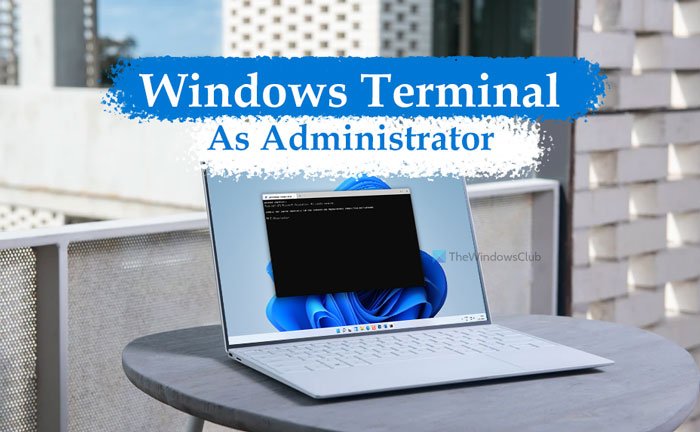
In Windows 10, Windows Terminal was an optional app that users could download from Microsoft Store. However, it comes as a pre-installed app in Windows 11. By default, if you try to open it from Start Menu or context menu, you would open it without administrator privilege. However, there could be times when you want to open this app with administrator permission.
How do I run Windows Terminal as administrator?
You can open and run Windows Terminal as an administrator using four different methods: Start Menu, Win+X menu, Task Manager, and context menu. However, if you want to open it quickly, the Win+X menu method seems handy since you have to press Win+X to find the option you are looking for.
To open Windows Terminal as an administrator in Windows 11, follow these steps:
- From Win+X menu
- From Start Menu/Taskbar search box
- From Task Manager
- Add context menu option
To learn more about these steps, continue reading.
1] From Win+X menu
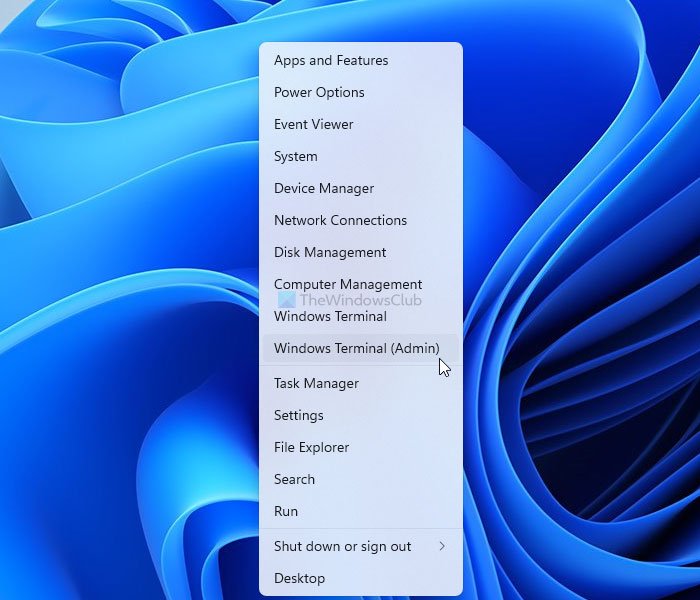
Microsoft introduced Win+X menu a long time back in Windows 8. This additional menu includes several options and apps that you can open on your computer. Earlier, it was possible to open Command Prompt or Windows PowerShell with and without administrator permission. However, now you can open Windows Terminal from the Win+X menu with and without administrator privilege. For that, press Win+X and select the Windows Terminal (Admin) option.
Then, you can select the Yes option in the UAC prompt.
2] From Start Menu/Taskbar search box

It is yet another simple method that you can use to open Windows Terminal as an administrator in Windows 11. You can use Start Menu to find out the app and the Taskbar search box to do the same. If you click on the Start Menu, it displays a list of apps on your screen. Then, click on the All apps button to find out all the installed apps.
From here, find out the Windows Terminal, right-click on it, and select the Run as administrator option.
As you are opening this app as an administrator, you have to click on the Yes option in the UAC prompt.
Alternatively, you can use the Taskbar search box to find out Windows Terminal, right-click on it and select the Run as administrator option.
As usual, click the Yes option.
Read: What is Windows PowerShell, PowerShell, Azure Cloud Shell, Command Prompt in Windows Terminal.
3] From Task Manager
Task Manager allows users to open any app with administrator permission. In Windows 11, there is no change in that functionality. Therefore, follow these steps to open Windows Terminal as administrator using Task Manager:
- Press Win+X to open the menu and select Task Manager.
- Click on File > Run new task.
- Type wt.exe and tick the Create this task with administrator privilege checkbox.
- Click the OK button.
4] Add context menu option
It is possible to use the Registry Editor to add the context menu option to open Windows Terminal as administrator. However, the only problem with this method is that you have to click on the Show more options in the original right-click context menu to find out this option.
Here is the detailed guide you can follow to add and open Windows Terminal with administrator privilege from the context menu.
How do I open PowerShell and Command Prompt as administrator in Terminal?
You can follow the same method to open PowerShell and Command Prompt as administrator. When you follow the aforementioned methods, Windows Terminal opens the default startup profile. However, if you change the default startup profile in Windows Terminal, it will open PowerShell or Command Prompt as administrator in Terminal.
That’s all! These are some of the methods to open Windows Terminal as administrator on Windows 11.


If you want your business to secure the most lucrative IT contracts, it’s essential to prove your expertise. The best way to achieve this is by earning professional certifications from top names like Microsoft. You just need the right exam prep.
Featuring 11 full-length video courses, the Complete 2024 Microsoft Tech Certification Training Super Bundle provides the ideal groundwork for your tech education in 2024. The included content is worth $429, but you can get lifetime access for only $79.99 via TechRepublic Academy.
If you work in IT or cybersecurity, you’re pretty much guaranteed to come across Microsoft technology. Around 85% of Fortune 500 companies currently use Azure, and many more businesses rely on other Microsoft products. Becoming a Microsoft Certified Expert can help you capture these potential customers.
With 246 hours of content, the 2024 Super Bundle covers a range of certifications and important skills. Through in-depth video tutorials, you learn how to manage multiple devices and identities, develop solutions for Azure, maintain security and more.
Each course works toward a specific certification. For example, you get full prep for Microsoft Security Operations Analyst (SC-200) and Designing Microsoft Azure Infrastructure Solutions (AZ-305). The lessons are easy to follow, and they include everything you need to know for the relevant exam.
All the content comes from IDUNOVA, an education provider that has been helping IT professionals for 20 years. You get unlimited on-demand access to all the materials, with streaming on desktop and mobile devices.
Order The Complete 2024 Microsoft Tech Certification Training Super Bundle for only $79.99, saving a massive $349 on the full price.
Prices and availability are subject to change.
In a Windows operating system, an Administrator account is an account that allows a user to make changes that require administrative permissions. An Administrator has more rights on a Windows OS as compared to the users with a local account. For example, the users with a local or standard account can access files and folders on their own user space, make system changes that do not require administrative permissions, install and uninstall programs, etc. On the other hand, an Administrator can change security settings, install and uninstall software, add and remove users, make changes to other user accounts, etc. In short, to perform the tasks that require administrative permissions, you should be logged in as an Administrator. In this tutorial, we will see how to log in as an Administrator in Windows 11/10.
Every Windows computer has a Local Administrator account that is created at the time of Windows installation. As described above, the Administrator has full access to the Windows device as compared to other standard users. The Administrator can also create new and delete the existing users and change the user account permissions. You can log in as an Administrator in Windows 11/10 by:
- Using the existing Administrator Account
- Enabling the built-in Administrator account
- Creating a new Local Administrator account
- Changing the local or standard into an Administrator account
Let’s see all these methods in detail.
1] Using the existing Administrator Account
If you are starting your PC then locate the Administrator account and use the password to login.
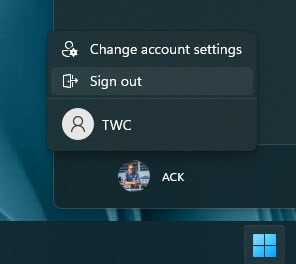
If you are currently not logged in as an administrator and want to change to an admin, open Start, click on the user icon, select Sign out and then log into the Admin account by using its password.
2] Enabling the built-in Administrator account
The Windows OS has a built-in Administrator account. In Windows 11/10 and Windows Server 2016, the built-in Administrator account is disabled at the time of Windows installation and another local account is created which is the member of the Administrators group.
The built-in Administrator account is also called the Super Administrator account. If we compare the built-in Administrator account with the Local Administrator account, the built-in Administrator account has elevated privileges. This means when you perform the administrative tasks, you will not get the UAC prompt. Apart from that, if you want to do some serious troubleshooting on your Windows machine or if you want to recover your main account or another user account, you can use the built-in Administrator account.
Because the built-in Administrator account does not show the UAC prompt, any application can have full control over your system. Therefore, running this account on a regular basis can be risky. You should enable the built-in Administrator account only if you have to do some troubleshooting or recover other user accounts. After performing your task, you should disable it.
As explained above, every Windows OS has a Local Administrator account which is created at the time of Windows installation. Hence, you have to sign in to that Local Administrator account in order to enable the built-in Administrator account. After enabling the built-in Administrator account, you can login as an Administrator in Windows 11/10.
3] Creating a new Local Administrator account
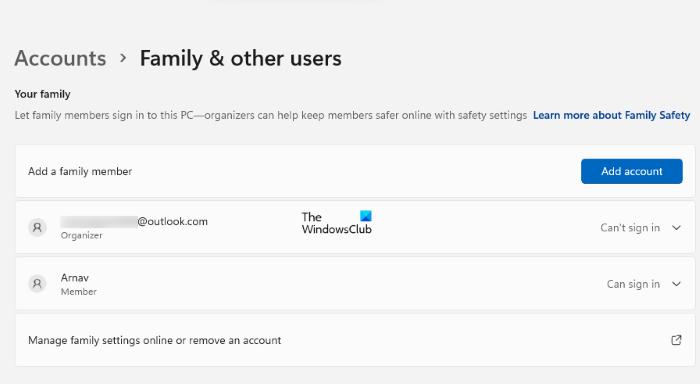
Every Windows 11/10 computer has a default Local Administrator account which is created at the time of Windows installation. Using that account, you can create another Local Administrator account for another user. To do so, open the Accounts page in your Windows 11/10 Settings and then click on the Family & other users option. Now, you have two options:
- You can create a Local Administrator account for your family member.
- You can create a Local Administrator account for a person who is not your family member.
Let’s see how to create a Local Administrator account for a family member and other users.
Create a Local Administrator account for your family member
You can use this option if you have another Microsoft account and you want to add that account as an Administrator to your Windows computer.
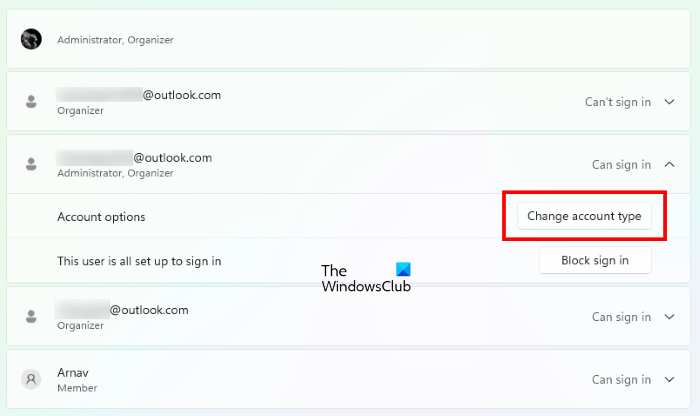
- On the Family & other users page in Windows 11/10 Settings, click on the Add account button next to the Add a family member option.
- Enter the email address of the family member and click Next.
- Select the role (organizer or member) and click Invite. After that, an invite will be sent to the email address.
- Open the email address and accept the invitation. After accepting the invitation, that account will be added automatically to your Windows device.
- Now, open the Family & other users page in WIndows 11/10 Accounts settings and select the newly added account.
- Click Change account type and select Administrator in the drop-down and click OK.
Now, you can login as an Administrator in Windows 11/10 using that account.
Create a Local Administrator account for a person who is not your family member
If you do not have another Microsoft account, you can still create a Local Administrator account. This time, you have to add an account in the Other users section on the Family & other users page. The steps are as follows:
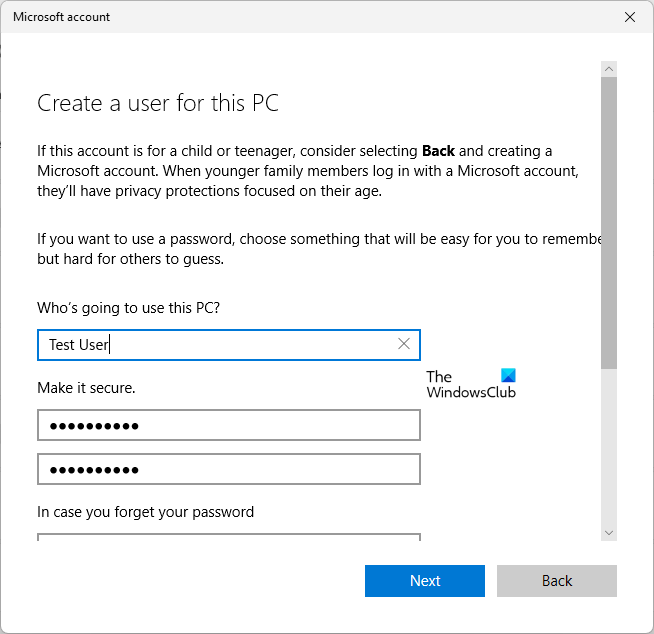
- Open the Family & other users page in Windows 11/10 Accounts settings.
- Click on the Add account button next to Add other user.
- You will be prompted to enter your email address. Click on the I don’t have this person’s sign-in information link.
- Now, click Add a user without a Microsoft account.
- Enter your username and password. After that, select the security questions and type your answers.
- Click Next.
- Now, select the newly created account and click Change account type.
- Select Administrator in the drop-down and click OK.
Now, you can use this account to login as an Administrator in Windows 11/10.
Read: How to rename built-in Administrator Account in Windows.
4] Changing the local or standard account into an Administrator account
If you already have created a local account on your Windows machine, you can change its type and use that account to login as an Administrator. The steps to change the local account to an Administrator account are as follows:
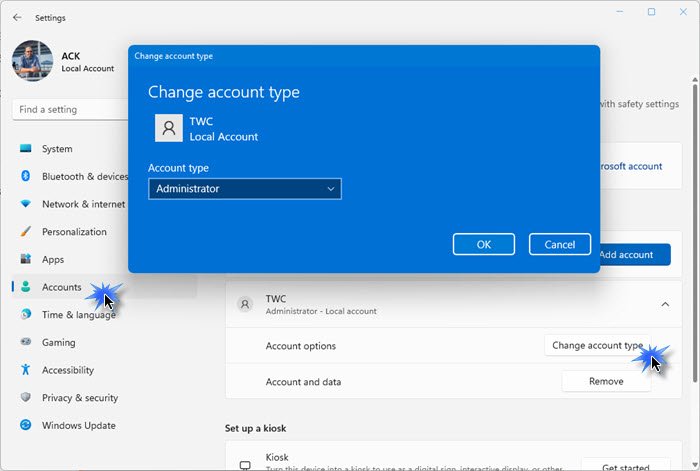
- Open the Family & other users page in Windows 11/10 Accounts settings.
- Select the local user account under the Other users section.
- Click on the Change account type button and select Administrator in the drop-down.
- Now, click OK.
How do I log onto my computer as an Administrator?
At the time of Windows installation, a Local Administrator account is created automatically. You can use that account to log onto your computer as an Administrator. Apart from that, you can also enable the hidden or built-in Administrator account or create an additional Local Administrator account.
We have explained all these methods above in this article.
How do I run Windows as an Administrator?
To run Windows as an Administrator, you should have an Administrator account. There are different methods by which you can create an Administrator account. In addition to this, you can also enable the built-in Administrator account. But it is not recommended to use the built-in Administrator account on a regular basis due to security issues.
This is all about how to log in as an Administrator in Windows 11/10.
Read next: How to fix the disabled Administrator account on Windows 11/10.

UPSC Public Administration Mains Syllabus 2023 PDF
The Public Administration optional syllabus is divided into two papers i.e. Paper I and Paper II in UPSC Mains exam. Each paper is conducted for 250 marks with a total of 500 marks. One must adhere to the UPSC Public Administration mains syllabus and the right resources to increase their chances of scoring high marks in the civil services exam. Mentioned below is the topic-wise UPSC Public Administration syllabus for both the papers discussed below.
UPSC Public Administration Mains Optional Syllabus for Paper I
The UPSC Public Administration Mains Syllabus for Paper I covers topics like Administrative Thought, Administrative Behaviour, Organisations, Accountability and Control, Administrative Law, Comparative Public Administration, Development Dynamics, Personnel Administration, etc. Check the topic-wise UPSC Public Administration mains Paper I syllabus shared below.
Administration Theory
- Introduction: Meaning, scope and significance of Public Administration, Wilson’s vision of Public Administration, Evolution of the discipline and its present status. New Public Administration, Public Choice approach; Challenges of liberalization, Privatisation, Globalisation; Good Governance: concept and application; New Public Management.
- Administrative Thought: Scientific Management and Scientific Management movement; Classical Theory; Weber’s bureaucratic model its critique and post-Weberian Developments; Dynamic Administration (Mary Parker Follett); Human Relations School (Elton Mayo and others); Functions of the Executive (C.I. Barnard); Simon’s decision making theory; Participative Management (R. Likert, C. Argyris, D. McGregor.)
- Administrative Behaviour: Process and techniques of decision-making; Communication; Morale; Motivation Theories content, process and contemporary; Theories of Leadership: Traditional and Modem:
- Organizations: Theories systems, contingency; Structure and forms: Ministries and Departments, Corporations, Companies; Boards and Commissions; Ad hoc, and advisory bodies; Headquarters and Field relationships; Regulatory Authorities; Public-Private Partnerships.
- Accountability and Control: Concepts of accountability and control; Legislative, Executive and judicial control over administration; Citizen and Administration; Role of media, interest groups, voluntary organizations; Civil society; Citizen’s Charters; Right to Information; Social audit.
- Administrative Law: Meaning, scope and significance; Dicey on Administrative law; Delegated legislation; Administrative Tribunals.
- Comparative Public Administration: Historical and sociological factors affecting administrative systems; Administration and politics in different countries; Current status of Comparative Public Administration; Ecology and administration; Riggsian models and their critique.
- Development Dynamics: Concept of development; Changing profile of development administration; ‘Anti-development thesis’; Bureaucracy and development; Strong state versus the market debate; Impact of liberalisation on administration in developing countries; Women and development the self-help group movement.
- Personnel Administration: Importance of human resource development; Recruitment, training, career advancement, position classification, discipline, performance appraisal, promotion, pray and service conditions; employer-employee relations, grievance redressal mechanism; Code of conduct; Administrative ethics.
- Public Policy: Models of policy-making and their critique; Processes of conceptualisation, planning, implementation, monitoring, evaluation and review and their limitations; State theories and public policy formulation.
- Techniques of Administrative Improvement: Organisation and methods, Work study and work management, e-governance and information technology; Management aid tools like network analysis, MIS, PERT, and CPM.
- Financial Administration: Monetary and fiscal policies: Public borrowings and public debt Budgets types and forms; Budgetary process; Financial accountability; Accounts and audit.
UPSC Public Administration Mains Syllabus for Paper II
The UPSC Public Administration Mains Syllabus for Paper II covers topics like the Evolution of Indian Administration, the Philosophical and Constitutional framework of Government, Public Sector Undertakings, Union Government and Administration, Plans and Priorities, State Government and Administration, etc. Check the topic-wise UPSC Public Administration mains Paper II syllabus shared below.
Indian Administration
- Evolution of Indian Administration: Kautilya Arthashastra; Mughal administration; Legacy of British rule in politics and administration Indianization of Public services, revenue administration, district Administration, local self Government.
- Philosophical and Constitutional framework of Government: Salient features and value premises; Constitutionalism; Political culture; Bureaucracy and democracy; Bureaucracy and development.
- Public Sector Undertakings: Public sector in modern India; Forms of Public Sector Undertakings; Problems of autonomy, accountability, and control; Impact of liberalization and privatization.
- Union Government and Administration: Executive, Parliament, Judiciary-structure, functions, work processes; Recent trends; Intra-governmental relations; Cabinet Secretariat; Prime Minister’s Office; Central Secretariat; Ministries and Departments; Boards; Commissions; Attached offices; Field organizations.
- Plans and Priorities: Machinery of planning; Role, composition and functions of the Planning Commission and the National Development Council; ‘Indicative’ planning; Process of plan formulation at Union and State levels; Constitutional Amendments (1992) and decentralized planning for economic development and social justice.
- State Government and Administration: Union-State administrative, legislative and financial relations; Role of the Finance Commission; Governor; Chief Minister; Council of Ministers; Chief Secretary; State Secretariat; Directorates.
- District Administration since Independence: The changing role of the Collector; Union-State-local relations; Imperatives of development management and law and order administration; District Administration and democratic decentralization.
- Civil Services: Constitutional position; Structure, recruitment, training and capacity building; Good governance initiatives; Code of conduct and discipline; Staff associations; Political rights; Grievance redressal mechanism; Civil service neutrality; Civil service activism.
- Financial Management: Budget as a political instrument; Parliamentary control of public expenditure; Role of finance ministry in monetary and fiscal area; Accounting techniques; Audit; Role of Controller General of Accounts and Comptroller and Auditor General of India.
- Administrative Reforms since Independence: Major concerns; Important Committees and Commissions; Reforms in financial management and human resource development; Problems of implementation.
- Rural Development: Institutions and agencies since Independence; Rural development programmes: foci and strategies; Decentralization and Panchayati Raj; 73rd Constitutional amendment.
- Urban Local Government: Municipal governance: main features, structures, finance and problem areas; 74th Constitutional Amendment; Global-local debate; New localism; Development dynamics, politics and administration with special reference to city management.
- Law and Order Administration: British legacy; National Police Commission; Investigative agencies; Role of Central and State Agencies including para military forces in maintenance of law and order and countering insurgency and terrorism; Criminalisation of politics and administration; Police-public relations; Reforms in Police.
- Significant issues in Indian Administration: Values in public service; Regulatory Commissions; National Human Rights Commission; Problems of administration in coalition regimes; Citizen administration interface; Corruption and administration; Disaster management
How to Prepare for UPSC Public Administration Mains Syllabus 2023?
Public Administration is one of the popular optional subjects in the UPSC mains exam. Therefore, one should clear the concepts of all the exam-relevant topics as it will allow them to answer the questions correctly in the exam. With this, they must develop a robust UPSC Public Administration preparation strategy and books. Check the best tips and tricks shared below to cover the entire UPSC Public Administration mains syllabus.
- Understand Syllabus: One should be well-acquainted with the UPSC Public Administration mains syllabus to cover all the topics and sub-topics important from an exam perspective.
- Clear Concepts: The next tip is to learn the fundamentals of all the topics prescribed in the syllabus. It is crucial to master the concepts thoroughly to answer the questions correctly in the exam.
- Previous Year Papers: Practice UPSC Public Administration's previous year's papers to understand the topics along with the question weightage asked in the exam.
- Practice of Answer-writing: After covering at least 40% of the syllabus, one should commence answer-writing practice. This will help them to learn the way to manage their time effectively with speed and accuracy.
- Solve Mock Tests: Candidates must practice full-length tests to analyze their performance and gauge their preparation level. Also, it will help them to discover their mistakes and allow them to focus more on their weak areas.
Booklist for UPSC Public Administration Mains Syllabus
A wide range of UPSC Public Administration books and resources are available online and in the local market that cover all the aspects of the UPSC Public Administration Mains Syllabus. Let’s look at the paper-wise books for the Public Administration optional subject shared below:
- Public Policy: Concept, Theory, and Practice by Bidyut Chakrabarty and Prakash Chand
- New Horizons of Public Administration by Mohit Bhattacharya
- Administrative Thinkers by Prasad and Prasad
- Public Administration-Laxmikant
- IGNOU BA and MA Notes
- Essentials of organizational behavior by Stephen Robbins
- Public Administration And Public Affairs by Nicholas Henry
Steven Sinofsky, the senior vice president for Office, made the announcement at the weekend's Microsoft MVP Global Summit in Redmond, Wash., a gathering of some 3,000 whom the company's designated as its Most Valuable Professionals.
Users will be able to save documents in PDF form by using the "Save As" command from within Office applications, said Sinofsky. "Instead of printing the document and faxing it, or overnight-mailing it, customers can save a PDF and electronically distribute a read-only, 'as-printed' representation of the document," he added in a statement.
Most of the applications that will be included in Office 12, as well as stand-alone programs which are part of Microsoft Office, will have the new capability, said Sinofsky, including Word, Excel, PowerPoint, Access, InfoPath, Visio, Publisher, and OneNote.
According to Betsy Frost, Microsoft's general manager of marketing, the move is a reaction to customer demand. "We've had a very significant amount of customer feedback about PDF," she said, "with up to 120,000 requests a month for the feature from Office users.
Microsoft is late to the PDF party. Other Windows application suites, including Corel's WordPerfect Office, Sun's StarOffice, and the free-of-charge, open-source OpenOffice.org, already have PDF publishing capabilities.
Adobe, which claims that the file type is the most popular on the Internet, made PDF available in a public specification in 1993; under that specification, Adobe lets other developers' software create PDFs without paying a licensing free.
"Microsoft's adding PDF validates the role of PDF in customer workflow," said Pam Deziel, the director of platform strategies for San Jose, Calif.-based Adobe.
Adobe and Microsoft have been longtime partners, but the two are increasingly at odds over turf such as forms -- Microsoft jumped into the market in 2003 with its InfoPath -- and photo editing. In mid-September, for instance, Microsoft said it was gunning for Adobe's PhotoShop with its own graphics package, code named "Acrylic Graphic Designer" for the moment.
Another direct attack on Adobe could come from Metro, a combination of file format, document viewer, and page description language planned as part of Windows Vista, the next-generation desktop client due out in late 2006.
"It's a natural part of business that Microsoft is entering areas where Adobe has products," Deziel said. "In the future, we'll be both cooperating and competing with Microsoft." When asked whether Adobe, which is in the final process of a $3.4 billion merger with Macromedia, is afraid of Microsoft intruding on its turf, Deziel side-stepped the question by simply saying "Microsoft is a $40 billion monopoly, and a formidable opponent."
Microsoft's addition of PDF to the file format list of Office could also be seen as a way to smooth relations with governments and businesses demanding open-source file formats for saving documents. Massachusetts, for example, has banned the purchase of software which doesn't save in "open" document formats; by Massachusetts' definition, PDF is such a format.
Microsoft, however, denied that the PDF add to Office 12 was a response to Massachusetts. "First and foremost this was an answer to our customers," said Microsoft's Frost.
Yet if the fallout was better relations with government agencies and private enterprises after open-standard file formats, all the better. "One of the key trends that businesses and government have is the sharing of information across organizational boundaries. With PDF, businesses or even government can take advantage of that capability [to share documents," Frost added.
Microsoft has said it hopes to ship Office 12 in late 2006.

Office Insiders trialing preview updates on iOS and iPadOS can download the latest Microsoft 365 app version with a great new feature: PDF Merge. Now you can grab several PDF documents and fuse them into one large file without downloading extra PDF managers.
You can try PDF merging in the Microsoft 365 application by downloading version 2.76 or newer (build 23062603). Next, head to the PDF toolbox, select the merge command, pick the files you need, and tap continue. Arrange the files or add more, then tap Merge and watch the app doing its software magic. After that, the Microsoft 365 app will automatically save the merged PDF file on your device, allowing you to find and retrieve it for further use or processing using existing PDF capabilities.

It is worth noting that the App Store on iOS and iPadOS is full of PDF-editing apps with document merging capabilities. Those features often require signing up for a paid subscription, and Microsoft is no exception—PDF merging is only available for Microsoft 365 subscribers. You can download and use the app for free, but attempting to fuse two or more PDF documents into one will result in Microsoft politely asking you to pay.
The updated Microsoft 365 app for iOS is rolling out to insiders gradually. Microsoft practices such an approach to ensure things are working smoothly. It is weird to see extra caution in the program for testing preview updates, but it is the sad reality of Microsoft's insider program.
Merging PDF files is not the only new PDF-related feature in the Microsoft 365 app. Earlier this month, the company introduced the ability to extract separate pages from PDF documents on Android. You can learn more about the feature in our dedicated coverage. Those willing to become Microsoft 365 insiders can visit the program's official website to get started.
MPPSC Syllabus 2023: The Madhya Pradesh Public Service Commission (MPPSC) syllabus consists of the History of MP & India, the Geography of MP & India, the constitutional system, science & technology and general aptitude. Download the MPSC Prelims Syllabus PDF and Exam Pattern here. All interested and eligible aspirants for MPPSC should download the latest MPPSC syllabus and exam pattern and align their preparation accordingly.
Apart from the MPPSC syllabus, candidates should be well-acquainted with the MPPSC exam pattern to understand the exam format, number of sections, total marks, and marking scheme prescribed by the commission. As per the exam expert analysis, it is reported that the questions asked in the MPPSC prelims exam are usually moderate in nature. Hence, aspirants must be familiar with the MPPSC State Service Exam Syllabus and create a list of topics based on their marks weightage and difficulty level.
In this blog, a detailed MPPSC Prelims Syllabus PDF is compiled, including the MPPSC Prelims exam pattern, preparation strategy, and list of important books.
MPPSC Prelims Syllabus 2023
Here is the major overview of the MPPSC Prelims syllabus and exam pattern tabulated below for the reference of the candidates aspiring for the upcoming civil service exam.
|
MPPSC Prelims Syllabus 2023 |
|
|
Exam Conducting Body |
Madhya Pradesh Public Service Commission |
|
Exam Name |
State Service Exam 2023 |
|
Category |
MPPSC Prelims Syllabus and Exam Pattern 2023 |
|
Selection Process |
Prelims, Mains, and Interview |
|
Maximum Marks |
200 |
|
Duration |
2 hours for each paper |
|
Negative Marking |
No negative marking |
MPPSC Prelims Syllabus 2023 PDF
Candidates must download the MPPSC Prelims Syllabus PDF from the links shared below to learn about the topics that need priority in the preparation. Get the direct link to download the MPPSC Syllabus 2023 PDF for the preliminary exam.
MPPSC Prelims Syllabus 2023-Important Topics
The MPPSC Prelims Syllabus PDF is divided into two papers, i.e., General Studies and General Aptitude Test. Both papers comprise objective-type questions, each carrying 200 marks. Check the topic-wise MPPSC Prelims Syllabus 2023 for all the sections below.
MPPSC Prelims Syllabus 2023 for General Studies
The MPPSC General Studies Syllabus PDF is divided into various sections, such as the history of MP & India, the Geography of MP, India, and the World, the constitutional system, science & technology, information and communication technology, etc. Check the detailed MPPSC Prelims Syllabus 2023 for General Studies below.
|
MPPSC Prelims Syllabus 2023 for General Studies |
|
|
Section |
Topics |
|
History, Culture, and Literature of Madhya Pradesh |
Contribution of Madhya Pradesh to the freedom movement. Major-arts and Sculpture of Madhya Pradesh. Major Tribes and Dialect of Madhya Pradesh. Major festivals, Polk music, Folk arts and folk literature of Madhya Pradesh. Important Literator of Madhya Pradesh and their literature. Religious and tourist places of Madhya Pradesh. |
|
History of India |
Major features, Events, and administrative, Social, and Economic Systems of Ancient and Medieval India. Social and Religious reform movements in the 19th and 20th century. Independence Struggle and Indian National Movement for Freedom Integration and Reorganization of India after Independence. |
|
Geography of Madhya Pradesh |
Forest, Forest Produce, Wildlife. Rivers, Mountains and Mountain ranges of Madhya Pradesh. Climate of Madhya Pradesh. Natural and Mineral Resources of Madhya Pradesh. Transports in Madhya Pradesh. Major Irrigation and Electrical Projects in Madhya Pradesh. Agriculture, Animal husbandry, and Agriculture based industries in Madhya Pradesh. |
|
Geography of World and India |
Physical Geography Physical features and Natural regions. Natural Resources: Forest, Mineral resources, Water, Agriculture, Wildlife, National Parks/Sanctuaries/Safari. Social Geography:- Population related, demography (Population growth, Sex Ratio, Literacy, and Economic activities) Economic Geography: Natural and Human resources (Industry; Modes of Transport) Continents/Countries/Oceans/Rivers/Mountains of the world. Conventional and Non-Conventional Energy Resources. |
|
Constitutional System of Madhya Pradesh |
Constitutional System of Madhya Pradesh (Governor, Council of Ministers, Legislative Assembly, High Court) Three Tier System of Panchayati Raj and Urban Administration in Madhya Pradesh |
|
Economy of Madhya Pradesh |
Demography and Census of Madhya Pradesh Economic Development of Madhya Pradesh Major Industries of Madhya Pradesh, etc. |
|
Constitution, Government, and Economy of India |
Government India Act 1919 and 1935. Constituent Assembly. Union Executive, President and Parliament. Fundamental Rights and Duties of the Citizens and Directive Principles of State Policy. Constitutional Amendments. Supreme Court and Judicial System. Indian Economy, Industrial Development and Foreign Trade, Import and Export. Financial Institutions- Reserve Bank of India, Nationalised Banks, Security and Exchange Board of India (SEBI), National Stock Exchange (NSE), Non-Banking Financial Institutions. |
|
Science and Technology |
Basic Principles of Science. Important Indian Scientific Research Institutions and their Achievements, Satellite and Space Technology. Environment and Biodiversity. Ecological System. Nutrition, Food and Nutrient. Human Body. Agricultural Product Technology. Food Processing. Health Policy and Programmes. Pollution, Natural Disasters and Management. |
|
Current International and National Affairs |
Important Personalities and Places. Major Events. Important Sports Institutes, Sports Competitions and Awards of India and Madhya Pradesh. |
|
Information and Communication Technology |
Electronics, Information and Communication Technology. Robotics, Artificial Intelligence and Cyber Security. E-Governance. Internet and Social Networking Sites. E-commerce. |
|
National and Regional Constitutional/Statutory Bodies |
Election Commission of India. State Election Commission. Union Public Service Commission. Madhya Pradesh Public Service Commission. Comptroller and Auditor General. NITI Aayog. Human Rights Commission. Women Commission. Child Protection Commission. Scheduled Castes and Scheduled Tribes Commission. Backward class Commission. Information Commission. Vigilance Commission. National Green Tribunal. Food Preservation Commission etc. |
MPPSC Prelims Syllabus 2023 for General Aptitude Test
The MPPSC General Aptitude Test Syllabus PDF is divided into various sections, such as comprehension, logical reasoning & analytical ability, general mental ability, basic numeracy, decision making, etc. Check the detailed MPPSC Prelims Syllabus 2023 for the General Aptitude Test below.
- Comprehension.
- Interpersonal skills including communication skills.
- Logical reasoning and analytical ability.
- Decision-making and problem-solving.
- General mental ability.
- Basic numeracy (number and their relations, order of magnitude, etc-Class X level). Data Interpretation (charts, graphs, table, data, sufficiency, etc-Class X level).
- Hindi Language Comprehension Skill (Class X level).
MPPSC Prelims Exam Pattern 2023
The MPPSC prelims examination consists of two papers i.e. General Studies and General Aptitude test and each paper will be of 2 hours of duration. Check the details below for the MPPSC prelims exam pattern
- The MPPSC Prelims Exam comprises objective-type multiple-choice questions.
- There are two papers in the MPPSC state service prelims exam pattern i.e., General Studies and General Aptitude Test.
- The exam duration for each paper shall be 2 hours.
- There shall be no negative marking for incorrect answers in the MPPSC Prelims exam.
|
MPPSC Prelims Exam Pattern 2023 |
||
|
Subject |
Maximum Marks |
Duration |
|
General Studies |
200 |
2 hours |
|
General Aptitude Test |
200 |
2 hours |
How to Cover MPPSC Prelims Syllabus 2023?
MPPSC State Service Examination is one of the most popular competitive exams in Madhya Pradesh. Many candidates apply for this prelims exam, but only a few can ace it with a well-planned strategy and the use of the right study material. Hence, analyzing the MPPSC syllabus is crucial to cover all the topics and their sub-topics. Here are the expert-recommended tips and tricks to crack the MPPSC State Service exam 2023.
- Check the MPPSC Prelims syllabus and exam pattern carefully and prioritize higher-weightage topics in the study plan.
- Get your hands on the best MPPSC prelims books and study materials to build conceptual clarity and learn core topics in a clear and defined manner.
- Attempt mock tests and MPPSC previous year's question papers to get insights into the nature and difficulty level of topics asked in the exam.
- Revise all the topics regularly to avoid forgetting any important concept on the exam day.
Best Books to Cover MPPSC Prelims Syllabus 2023
Candidates should pick the finest MPPSC prelims books based on the revised exam requirements, trends, and format. This will help them to build a strong grip on the topics specified in the MPPSC Prelims Syllabus PDF. Check the expert-recommended MPPSC Prelims Syllabus PDF below.
- Indian Polity (4 & 5edition) by M. Laxmikant
- Madhya Pradesh Ek Parichaya by McGraw Hill Publication
- Fast track objective Arithmetic by Rajesh Verma
- Spectrum for Modern Indian History by Rajiv Ahir
- Quantitative Aptitude for competitive exam by RS Agarwal
- A new approach to reasoning verbal, non-verbal & Analytical by Arihant Publication
- Indian Yearbook by GOI Publication
- An Introduction to Madhya Pradesh General Knowledge by Sonali Bansal
Also Read,
Microsoft Download Manager is a download manager application that helps you start, pause or stop downloads, organize the active downloads and view important information, such as size, location and status, about your downloads. You can download Microsoft Download Manager from Microsoft and use it for free to download any files that interest you. However, it is illegal to download copyrighted files using the Microsoft Download Manager. Also, you need to know the URL of the file to start downloading it.
-
Launch the Microsoft Download Manager application and locate the URL of the file that you wish to download. In Mozilla Firefox, you can right-click a link and choose "Copy Link Location" to copy the URL to the clipboard. In Google Chrome, you have to right-click the link and choose "Copy Link Address" from the context menu. In Internet Explorer you must choose "Copy Shortcut" from the context menu. Of course, you can select the URL in the address bar and press "Ctrl-C" to copy it to the clipboard.
-
Click the "Settings" icon in the Microsoft Download Manager window, click "Browse" in the Destination Folder section and select the folder where you want to store the downloads. Click "Apply" and select "OK."
-
Click the "New Download" icon to open the Add A Download window.
-
Press "Ctrl-V" to paste the URL of the file into the URL field and click "OK" to start the download.
-
Click the drop-down menu in the Action column and use the options in the menu to organize your download. To navigate to the file, select the "Open file location" option. To stop the download, select the "Remove from list" option.
AZ-104 Study Guide | AZ-104 education | AZ-104 guide | AZ-104 thinking | AZ-104 mission | AZ-104 learning | AZ-104 outline | AZ-104 plan | AZ-104 questions | AZ-104 test prep |
Killexams Exam Simulator
Killexams Questions and Answers
Killexams Exams List
Search Exams